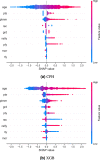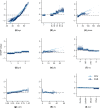Explainable machine learning can outperform Cox regression predictions and provide insights in breast cancer survival
- PMID: 33772109
- PMCID: PMC7998037
- DOI: 10.1038/s41598-021-86327-7
Explainable machine learning can outperform Cox regression predictions and provide insights in breast cancer survival
Abstract
Cox Proportional Hazards (CPH) analysis is the standard for survival analysis in oncology. Recently, several machine learning (ML) techniques have been adapted for this task. Although they have shown to yield results at least as good as classical methods, they are often disregarded because of their lack of transparency and little to no explainability, which are key for their adoption in clinical settings. In this paper, we used data from the Netherlands Cancer Registry of 36,658 non-metastatic breast cancer patients to compare the performance of CPH with ML techniques (Random Survival Forests, Survival Support Vector Machines, and Extreme Gradient Boosting [XGB]) in predicting survival using the [Formula: see text]-index. We demonstrated that in our dataset, ML-based models can perform at least as good as the classical CPH regression ([Formula: see text]-index [Formula: see text]), and in the case of XGB even better ([Formula: see text]-index [Formula: see text]). Furthermore, we used Shapley Additive Explanation (SHAP) values to explain the models' predictions. We concluded that the difference in performance can be attributed to XGB's ability to model nonlinearities and complex interactions. We also investigated the impact of specific features on the models' predictions as well as their corresponding insights. Lastly, we showed that explainable ML can generate explicit knowledge of how models make their predictions, which is crucial in increasing the trust and adoption of innovative ML techniques in oncology and healthcare overall.
Conflict of interest statement
The authors declare no competing interests.
Figures





References
-
- Cox DR. Regression models and life-tables. J. R. Stat. Soc. Ser. B (Methodol.) 1972;34:187–202.
-
- Wang P, Li Y, Reddy CK. Machine learning for survival analysis: A survey. ACM Comput. Surv. (CSUR) 2019;51:1–36. doi: 10.1145/3214306. - DOI
MeSH terms
LinkOut - more resources
Full Text Sources
Other Literature Sources
Medical
Research Materials

